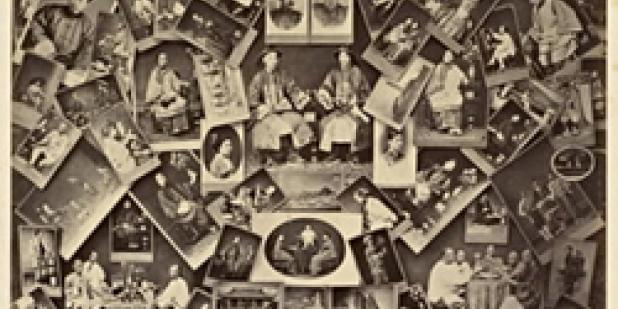Join us for a free one-day workshop for educators at the Japanese American National Museum, hosted by the USC U.S.-China Institute and the National Consortium for Teaching about Asia. This workshop will include a guided tour of the beloved exhibition Common Ground: The Heart of Community, slated to close permanently in January 2025. Following the tour, learn strategies for engaging students in the primary source artifacts, images, and documents found in JANM’s vast collection and discover classroom-ready resources to support teaching and learning about the Japanese American experience.
Brush & Shutter: Early Photography in China
An exhibition on early photography in China is held at the J. Paul Getty Museum.

Brush & Shutter: Early Photography in China on view at the J. Paul Getty Museum at the Getty Center, from February 8 through May 1, 2011, seeks to redefine the history of photography in China by illuminating the intersection of traditional Chinese artistic media and the modern technology of photography, drawing special attention to indigenous Chinese photographers.
Brought to Asia in the early 1840s by European travelers, photography was both a witness to the dramatic changes that took place in China through the early-twentieth century, and a catalyst for further modernization. Employing both ink brush and camera, Chinese painters adapted the new medium, grafting it onto traditional aesthetic conventions.
"Until now, these early photographs have received scant attention and there has been little attempt to study them within a social and cultural context. This exhibition helps provide a historical and visual background for understanding modern and contemporary China and its current relation with the West," said Frances Terpak, curator of photographs in the Getty Research Institute.
The exhibition features more than 100 works, culled primarily from the Getty Research Institute's strong holdings on the early history of photography in China. The works in the exhibition range from an 1859 portrait of a Chinese family made near Shanghai to glass slides of revolutionary soldiers created in 1911 in Shansi province.
Organized into five sections, the exhibition, which coincides with the beginning of the Chinese New Year of the Rabbit, includes works by Lai Afong and Tung Hing, two of the most notable Chinese photographers of the nineteenth century. Lai's specialty was the closely observed portrait group, while Hing was a master of Chinese landscape, excelling in extraordinary multipart photographic panoramas. Hing's six-part landscape of the Min River snaking through the city of Fuzhou exemplifies how Asian photographers drew upon the Chinese literati tradition of landscape scrolls for inspiration. Also notable are a series of photographs depicting street trades and goods made for Chinese export, and rare gouache and oil paintings made by Chinese painters, such as the Cantonese artist Tingqua, on loan to the exhibition from The Kelton Foundation in Los Angeles.
Brush & Shutter: Early Photography in China runs concurrently with Felice Beato: A Photographer on the Western Road and Photography from the New China (on view in the J. Paul Getty Museum's Center for Photographs from December 7, 2010 through April 24, 2011), which explore nineteenth-century views of Asia and contemporary Chinese photography.
Along with In Focus: The Tree, opening February 8, the photography exhibitions this winter and spring at the Getty Center represent important thematic links across the programs of the J. Paul Getty Trust.
Brush & Shutter: Early Photography in China is co-organized by the Getty Research Institute and the J. Paul Getty Museum, and is curated by Jeffrey Cody, senior project specialist in the Getty Conservation Institute's Education Department, and Frances Terpak, curator of photographs at the Getty Research Institute.
Cody and Terpak also share a substantial role in the richly illustrated exhibition catalogue of the same name, published by the Getty Research Institute and the Hong Kong University Press. The catalogue—with 75 black-and-white and 61 color reproductions—explores the introduction of photography to China, the cultural shifts that heralded the technology's arrival, and photography's reception by indigenous Chinese reformers. The essays shed new light on the birth of a medium within a culture defined by tradition.
Related exhibition events include curatorial, guest lectures and tours in English and Mandarin, screenings of early Chinese films, and a highly anticipated concert by Wu Man, an acclaimed virtuoso of the pipa (Chinese lute).
Featured Articles
Please join us for the Grad Mixer! Hosted by USC Annenberg Office of International Affairs, Enjoy food, drink and conversation with fellow students across USC Annenberg. Graduate students from any field are welcome to join, so it is a great opportunity to meet fellow students with IR/foreign policy-related research topics and interests.
RSVP link: https://forms.gle/1zer188RE9dCS6Ho6
Events
Hosted by USC Annenberg Office of International Affairs, enjoy food, drink and conversation with fellow international students.
Join us for an in-person conversation on Thursday, November 7th at 4pm with author David M. Lampton as he discusses his new book, Living U.S.-China Relations: From Cold War to Cold War. The book examines the history of U.S.-China relations across eight U.S. presidential administrations.




